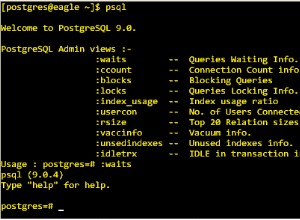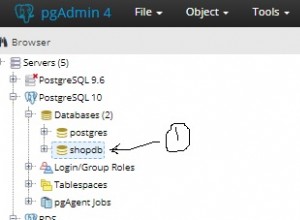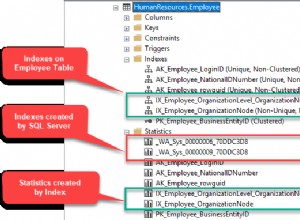Estaba buscando una solución similar en concepto al menos a la de Wernfried, pero creo que también es lo suficientemente diferente como para publicarla. El comienzo es la misma idea, primero generando los posibles intervalos de tiempo y suponiendo que está viendo ventanas de 15 minutos:estoy usando CTE porque creo que son más claros que las selecciones anidadas, particularmente con tantos niveles.
with date_time_range as (
select to_date('10/10/2013 07:00', 'DD/MM/YYYY HH24:MI') as date_start,
to_date('10/10/2013 21:15', 'DD/MM/YYYY HH24:MI') as date_end
from dual
),
time_slots as (
select level as slot_num,
dtr.date_start + (level - 1) * interval '15' minute as slot_start,
dtr.date_start + level * interval '15' minute as slot_end
from date_time_range dtr
connect by level <= (dtr.date_end - dtr.date_start) * (24 * 4) -- 15-minutes
)
select * from time_slots;
Esto le da los 57 intervalos de 15 minutos entre la fecha de inicio y finalización que especificó. El CTE para date_time_range no es estrictamente necesario, puede poner sus fechas directamente en los time_slots condiciones, pero tendría que repetirlas y eso introduce un posible punto de falla (y significa vincular el mismo valor varias veces, desde JDBC o donde sea).
Esos espacios se pueden unir a la lista de aulas, que supongo que ya están en otra tabla, lo que le da 171 (3x57) combinaciones; y se pueden comparar con las reservas existentes:una vez que se eliminan, te quedan los 153 espacios de 15 minutos que no tienen reserva.
with date_time_range as (...),
time_slots as (...),
free_slots as (
select c.classroom, ts.slot_num, ts.slot_start, ts.slot_end,
lag(ts.slot_end) over (partition by c.classroom order by ts.slot_num)
as lag_end,
lead(ts.slot_start) over (partition by c.classroom order by ts.slot_num)
as lead_start
from time_slots ts
cross join classrooms c
left join occupied_classrooms oc on oc.classroom = c.classroom
and not (oc.occupied_end <= ts.slot_start
or oc.occupied_start >= ts.slot_end)
where oc.classroom is null
)
select * from free_slots;
Pero luego tienes que colapsarlos en rangos contiguos. Hay varias formas de hacerlo; aquí estoy echando un vistazo a las filas anterior y siguiente para decidir si un valor en particular es el borde de un rango:
with date_time_range as (...),
time_slots as (...),
free_slots as (...),
free_slots_extended as (
select fs.classroom, fs.slot_num,
case when fs.lag_end is null or fs.lag_end != fs.slot_start
then fs.slot_start end as slot_start,
case when fs.lead_start is null or fs.lead_start != fs.slot_end
then fs.slot_end end as slot_end
from free_slots fs
)
select * from free_slots_extended
where (fse.slot_start is not null or fse.slot_end is not null);
Ahora estamos en 12 filas. (El exterior where elimina las 141 de las 153 ranuras del paso anterior que son de rango medio, ya que solo nos preocupamos por los bordes):
CLASSROOM SLOT_NUM SLOT_START SLOT_END
--------- ---------- ---------------- ----------------
A 1 2013-10-10 07:00
A 12 2013-10-10 10:00
A 19 2013-10-10 11:30
A 57 2013-10-10 21:15
B 1 2013-10-10 07:00
B 9 2013-10-10 09:15
B 16 2013-10-10 10:45
B 30 2013-10-10 14:30
B 37 2013-10-10 16:00
B 57 2013-10-10 21:15
C 1 2013-10-10 07:00
C 57 2013-10-10 21:15
Esos representan los bordes, pero en filas separadas, y un paso final los combina:
...
select distinct fse.classroom,
nvl(fse.slot_start, lag(fse.slot_start)
over (partition by fse.classroom order by fse.slot_num)) as slot_start,
nvl(fse.slot_end, lead(fse.slot_end)
over (partition by fse.classroom order by fse.slot_num)) as slot_end
from free_slots_extended fse
where (fse.slot_start is not null or fse.slot_end is not null)
O juntando todo eso:
with date_time_range as (
select to_date('10/10/2013 07:00', 'DD/MM/YYYY HH24:MI') as date_start,
to_date('10/10/2013 21:15', 'DD/MM/YYYY HH24:MI') as date_end
from dual
),
time_slots as (
select level as slot_num,
dtr.date_start + (level - 1) * interval '15' minute as slot_start,
dtr.date_start + level * interval '15' minute as slot_end
from date_time_range dtr
connect by level <= (dtr.date_end - dtr.date_start) * (24 * 4) -- 15-minutes
),
free_slots as (
select c.classroom, ts.slot_num, ts.slot_start, ts.slot_end,
lag(ts.slot_end) over (partition by c.classroom order by ts.slot_num)
as lag_end,
lead(ts.slot_start) over (partition by c.classroom order by ts.slot_num)
as lead_start
from time_slots ts
cross join classrooms c
left join occupied_classrooms oc on oc.classroom = c.classroom
and not (oc.occupied_end <= ts.slot_start
or oc.occupied_start >= ts.slot_end)
where oc.classroom is null
),
free_slots_extended as (
select fs.classroom, fs.slot_num,
case when fs.lag_end is null or fs.lag_end != fs.slot_start
then fs.slot_start end as slot_start,
case when fs.lead_start is null or fs.lead_start != fs.slot_end
then fs.slot_end end as slot_end
from free_slots fs
)
select distinct fse.classroom,
nvl(fse.slot_start, lag(fse.slot_start)
over (partition by fse.classroom order by fse.slot_num)) as slot_start,
nvl(fse.slot_end, lead(fse.slot_end)
over (partition by fse.classroom order by fse.slot_num)) as slot_end
from free_slots_extended fse
where (fse.slot_start is not null or fse.slot_end is not null)
order by 1, 2;
Lo que da:
CLASSROOM SLOT_START SLOT_END
--------- ---------------- ----------------
A 2013-10-10 07:00 2013-10-10 10:00
A 2013-10-10 11:30 2013-10-10 21:15
B 2013-10-10 07:00 2013-10-10 09:15
B 2013-10-10 10:45 2013-10-10 14:30
B 2013-10-10 16:00 2013-10-10 21:15
C 2013-10-10 07:00 2013-10-10 21:15




